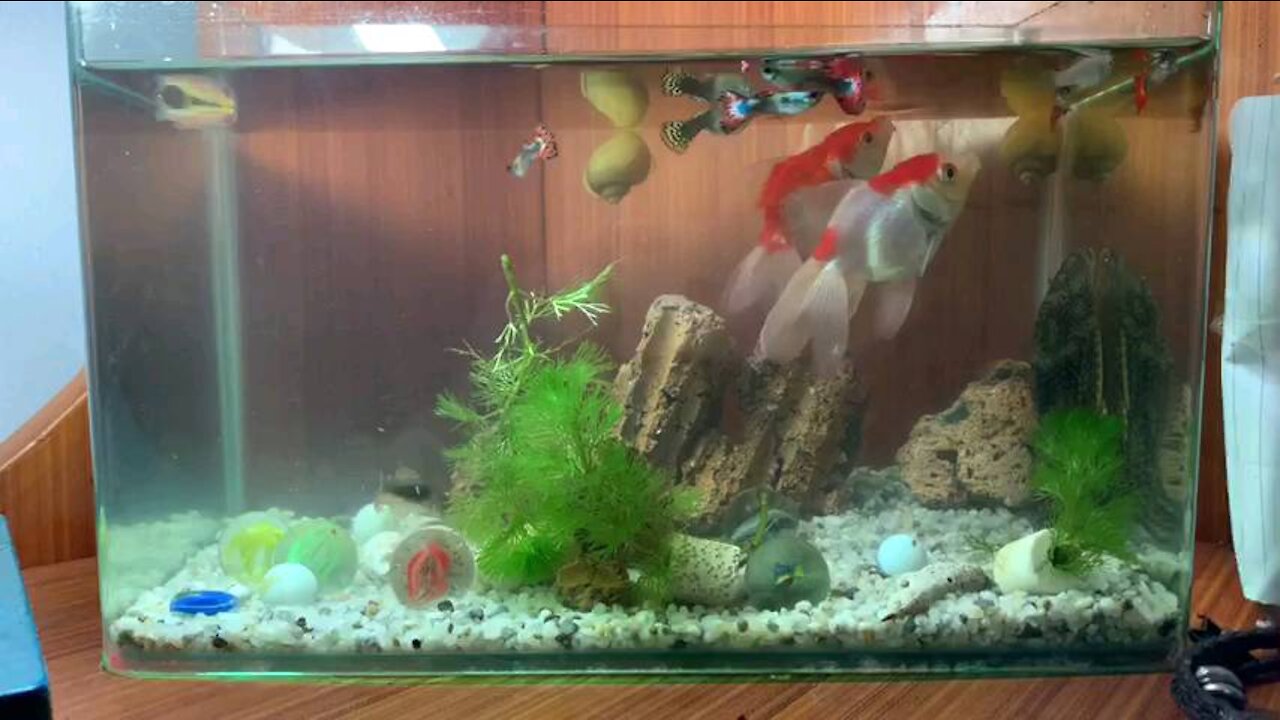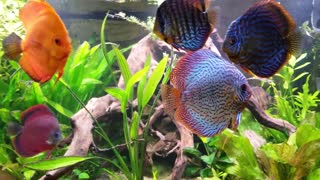Premium Only Content

Hold the aquarium fish - water school garden
In 1832, Jeanne Villepreux-Power, a pioneering French marine biologist, became the first person to create aquaria for experimenting with aquatic organisms. In 1836, soon after his invention of the Wardian case, Dr. Nathaniel Bagshaw Ward proposed to use his tanks for tropical animals. In 1841 he did so, though only with aquatic plants and toy fish. However, he soon housed real animals. In 1838, Félix Dujardin noted owning a saltwater aquarium, though he did not use the term. In 1846, Anne Thynne maintained stony corals and seaweed for almost three years, and was credited as the creator of the first balanced marine aquarium in London.English chemist Robert Warington experimented with a 13-gallon container, which contained goldfish, eelgrass, and snails, creating one of the first stable aquaria. The aquarium principle was fully developed by Warington, explaining that plants added to water in a container would give off enough oxygen to support animals, so long as their numbers do not grow too large.He published his findings in 1850 in the Chemical Society's journal.
The Jardin zoologique at the Bois de Boulogne included an aquarium that housed both fresh and saltwater animals, 1860 in Paris.
The keeping of fish in an aquarium became a popular hobby and spread quickly. In the United Kingdom, it became popular after ornate aquaria in cast-iron frames were featured at the Great Exhibition of 1851. In 1853, the aquarium craze was launched in England by Philip Henry Gosse who created and stocked the first public aquarium in the London Zoo which came to be known as the Fish House. Gosse coined the word "aquarium", opting for this term (instead of "aquatic vivarium" or "aqua-vivarium") in 1854 in his book The Aquariums: An Unveiling of the Wonders of the Deep Water. In this book, Gosse primarily discussed saltwater aquaria. In the 1850s, the aquarium became a fade in the United Kingdom.Tank designs and techniques for maintaining water quality were developed by Warington, later cooperating with Gosse until his critical review of the tank water composition. Edward Edwards developed these glass-fronted aquaria in his 1858 patent for a "dark-water-chamber slope-back tank", with water slowly circulating to a reservoir beneath.
"What an Aquarium Should Be" – a humorous 1876 British engraving, apparently showing Thomas Huxley dreaming about sea creatures
Germans soon rivaled the British in their interest. In 1854, an anonymous author had two articles published about the saltwater aquaria of the United Kingdom: Die Gartenlaube (The Garden House) entitled Der Ocean auf dem Tische (The Ocean on the Table). However, in 1856, Der See im Glase (The Lake in a Glass) was published, discussing freshwater aquaria, which were much easier to maintain in landlocked areas. In 1862 William Alford Lloyd, then bankrupt because of the craze in England being over, moved to Grindel Dammthor, Hamburg, to supervise the installation of the circulating system and tanks at the Hamburg Aquarium.[citation needed] During the 1870s, some of the first aquarist societies were appearing in Germany.The United States soon followed. Published in 1858, Henry D. Butler's The Family Aquarium was one of the first books written in the United States solely about the aquarium.According to the July issue of The North American Review of the same year, William Stimson may have owned some of the first functional aquaria, and had as many as seven or eight.[18] The first aquarist society in the United States was founded in New York City in 1893, followed by others.The New York Aquarium Journal, first published in October 1876, is considered to be the world's first aquarium magazine.
An antique cast-iron aquarium made by J. W. Fiske & Company in the 1880s, New York City
In the Victorian era in the United Kingdom, a common design for the home aquarium was a glass front with the other sides made of wood (made watertight with a pitch coating). The bottom would be made of slate and heated from below.More advanced systems soon began to be introduced, along with tanks of glass in metal frames. During the latter half of the 19th century, a variety of aquarium designs were explored, such as hanging the aquarium on a wall, mounting it as part of a window, or even combining it with a birdcage.
-
 2:33
2:33
WKBW
5 years agoSchool House 7 Water
34 -
 0:11
0:11
Pchelkin
5 years ago $0.06 earnedFish in aquarium
157 -
 2:07
2:07
WEWS
4 years agoCommunity garden at Akron school teaching kids about healthy eating
68 -
 3:00
3:00
ReallyRelaxAndMore
4 years agoAutumn Stream Fish Swimming in Natural Habitat Nature's Aquarium Colorful Leaves Floating on Water
11 -
 0:10
0:10
Cherednik
5 years ago $0.02 earnedHedgehog drinks water in my garden
241 -
 0:22
0:22
slavatsarev
5 years agoPond with fish, Montreal, Botanical garden
88 -
 0:28
0:28
erikabeutels
5 years ago $0.03 earnedExotic sweet water fish!
196 -
 1:12
1:12
HenryF
4 years ago $0.03 earnedYellow Goat Fish School @ Bonaire N.A. - October 2019
501 -
 0:21
0:21
Ferik203
5 years ago $0.03 earnedFunniest fish inside the AQUARIUM
2141 -
 0:17
0:17
Davidnhando
5 years agoBig shark look like sleep, sea, aquarium, water, control
45